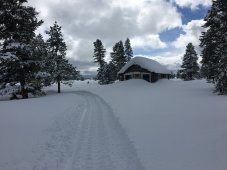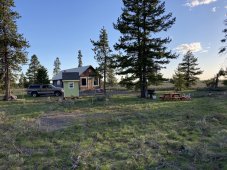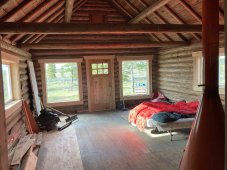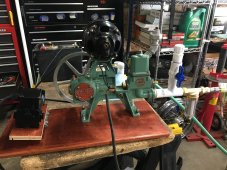Greetings, I’m brand new to the forum; I’m very electrically challenged, but I’m learning…. I’ve really enjoyed watching videos from Will and others, and appreciate the education I’m getting.
In 2018 I purchased an old cabin that was about to be destroyed to make way for a new hotel in Island Park, Idaho, not far from Yellowstone National Park. I had it moved and put on a new foundation on my property about 8 miles from where it was born. I’ve been slowly working its rehab ever since. Summer temps are warm and wonderful but winters are COLD. -20F is typical, -40F is not uncommon and -60F (coldest in Idaho history) was recorded less than 6 miles from my cabin on 1/18/1943. Access is limited to snowmobile or tracked vehicles 6 months a year.
Cabin Details: 17’x36’ sitting on a 9ft tall basement, will be wood fireplace warmed, will never be insulated.
Off grid - no power to the property.
The cabin is not presently wired. I hope to wire it soon and am now leaning toward conventional 120VAC.
I have a shallow sand point well that I installed myself. To pump water I just graduated from a hand pump to a rebuilt 1926 Duro Piston Pump that I have been powering with either the original 120VAC motor (generator) or a 12V/24V DC motor (battery). I built and permitted an outhouse. The wife and her lady friends like it. When I have solar power, I will get internet access.
Use: Summertime could be 3-4 days at a time with a week of recharging in between. Winter will be several overnights a season, typically a single overnight, but never more than 2.
The important details: My first cut at a stingy energy need calc was 2350W (summer) and 1500 (winter). With 5 & 3 summer & winter peak sun hours respectively, I got a 540W summer and 350W needs (minimum). Because of the decreasing cost of panels, I’m thinking I’de like 1000-1200 Watts +/- of panels.
By far the best place to site my solar array will be 115’ south of the cabin. So the distance from the solar panels to my basement battery and power management location will be 130ft.
Because of the distance to panels, I’m leaning toward a 24V system (48V scares me).
I’m also leaning toward an “All-in-one” Charger/Inverter system, and am open to any battery type, but I know the extreme cold may be a controlling factor for both the power management system and batteries.
My basement is 9 ft tall, but only about 5.5 ft below grade. I know I get warmth from the ground and a insulation from the surrounding snow, but I’m making an assumption that I could get as cold as -5F down there at times (at present cabin is more than drafty and the floor is not insulated between the basement). If anyone had data that could refine my hopefully conservative temp guesstimate, I’d appreciate it as this really seems to exclude most all-in-one charger/inverter systems.
For the charger/inverters I like the cost and good reviews and large following of the MPP and Growatt systems but their lower operating temp is listed as 0C (32F) and this just won’t cut it (as I understand it - though I suspect I could build some kind of insulated box around it for wintertime only installation). Midnight Solar’s MN3024DIY has a better lower operating temperature limit (-15C/5F), but reviews don’t appear as good and that temp limit may not cut it. The Victron EasySolar 24/1600/40 is rated at -20C (-4F) which would probably work and seems well sized for my needs, though it’s big brother, Victron EasySolar 24/3000/70-50, is rated to -40C / -40F which is the best I’ve seen for lower temps.
Apologies about my long diatribe. Any help on selecting the charger/inverter, the battery types/size or anything including design help would be greatly appreciated. I also included a few pictures of my diamond in the rough in case you were interested, Cheers and thanks in advance,
Hopitrout
In 2018 I purchased an old cabin that was about to be destroyed to make way for a new hotel in Island Park, Idaho, not far from Yellowstone National Park. I had it moved and put on a new foundation on my property about 8 miles from where it was born. I’ve been slowly working its rehab ever since. Summer temps are warm and wonderful but winters are COLD. -20F is typical, -40F is not uncommon and -60F (coldest in Idaho history) was recorded less than 6 miles from my cabin on 1/18/1943. Access is limited to snowmobile or tracked vehicles 6 months a year.
Cabin Details: 17’x36’ sitting on a 9ft tall basement, will be wood fireplace warmed, will never be insulated.
Off grid - no power to the property.
The cabin is not presently wired. I hope to wire it soon and am now leaning toward conventional 120VAC.
I have a shallow sand point well that I installed myself. To pump water I just graduated from a hand pump to a rebuilt 1926 Duro Piston Pump that I have been powering with either the original 120VAC motor (generator) or a 12V/24V DC motor (battery). I built and permitted an outhouse. The wife and her lady friends like it. When I have solar power, I will get internet access.
Use: Summertime could be 3-4 days at a time with a week of recharging in between. Winter will be several overnights a season, typically a single overnight, but never more than 2.
The important details: My first cut at a stingy energy need calc was 2350W (summer) and 1500 (winter). With 5 & 3 summer & winter peak sun hours respectively, I got a 540W summer and 350W needs (minimum). Because of the decreasing cost of panels, I’m thinking I’de like 1000-1200 Watts +/- of panels.
By far the best place to site my solar array will be 115’ south of the cabin. So the distance from the solar panels to my basement battery and power management location will be 130ft.
Because of the distance to panels, I’m leaning toward a 24V system (48V scares me).
I’m also leaning toward an “All-in-one” Charger/Inverter system, and am open to any battery type, but I know the extreme cold may be a controlling factor for both the power management system and batteries.
My basement is 9 ft tall, but only about 5.5 ft below grade. I know I get warmth from the ground and a insulation from the surrounding snow, but I’m making an assumption that I could get as cold as -5F down there at times (at present cabin is more than drafty and the floor is not insulated between the basement). If anyone had data that could refine my hopefully conservative temp guesstimate, I’d appreciate it as this really seems to exclude most all-in-one charger/inverter systems.
For the charger/inverters I like the cost and good reviews and large following of the MPP and Growatt systems but their lower operating temp is listed as 0C (32F) and this just won’t cut it (as I understand it - though I suspect I could build some kind of insulated box around it for wintertime only installation). Midnight Solar’s MN3024DIY has a better lower operating temperature limit (-15C/5F), but reviews don’t appear as good and that temp limit may not cut it. The Victron EasySolar 24/1600/40 is rated at -20C (-4F) which would probably work and seems well sized for my needs, though it’s big brother, Victron EasySolar 24/3000/70-50, is rated to -40C / -40F which is the best I’ve seen for lower temps.
Apologies about my long diatribe. Any help on selecting the charger/inverter, the battery types/size or anything including design help would be greatly appreciated. I also included a few pictures of my diamond in the rough in case you were interested, Cheers and thanks in advance,
Hopitrout







